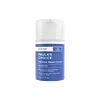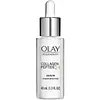What's inside
What's inside
 Key Ingredients
Key Ingredients

 Benefits
Benefits

 Concerns
Concerns

 Ingredients Side-by-side
Ingredients Side-by-side

Water
Skin ConditioningEthylhexyl Stearate
EmollientSimmondsia Chinensis Seed Oil
EmollientButylene Glycol
HumectantGlycerin
HumectantCaprylic/Capric Triglyceride
MaskingPetrolatum
EmollientCetearyl Alcohol
EmollientDimethicone
EmollientDipentaerythrityl Hexacaprylate/Hexacaprate
EmulsifyingGlyceryl Stearate
EmollientTridecyl Trimellitate
EmollientPEG-100 Stearate
Phenyl Trimethicone
Skin ConditioningRetinol
Skin ConditioningAdenosine
Skin ConditioningPalmitoyl Tetrapeptide-7
Skin ConditioningPalmitoyl Hexapeptide-12
Skin ConditioningPalmitoyl Tripeptide-1
Skin ConditioningCeramide Ng
Skin ConditioningSodium Hyaluronate
HumectantMagnesium Ascorbyl Phosphate
AntioxidantNiacinamide
SmoothingTocopherol
AntioxidantLecithin
EmollientLinoleic Acid
CleansingLinolenic Acid
CleansingRetinyl Palmitate
Skin ConditioningGlycyrrhiza Glabra Root Extract
BleachingCamellia Oleifera Leaf Extract
AstringentCitrullus Lanatus Fruit Extract
Skin ConditioningLens Esculenta Fruit Extract
Skin ConditioningPyrus Malus Fruit Extract
Skin ConditioningGlycine Soja Sterols
EmollientTribehenin
EmollientPEG-10 Phytosterol
EmulsifyingMagnesium Aluminum Silicate
AbsorbentSodium PCA
HumectantSodium Lactate
BufferingPullulan
Xanthan Gum
EmulsifyingSodium Hydroxide
BufferingNeopentyl Glycol Dicaprylate/Dicaprate
EmollientCetearyl Glucoside
EmulsifyingTridecyl Stearate
EmollientBehenyl Alcohol
EmollientSclerotium Gum
Emulsion StabilisingCarbomer
Emulsion StabilisingC12-15 Alkyl Benzoate
AntimicrobialPolysorbate 20
EmulsifyingDisodium EDTA
Sorbic Acid
PreservativePhenoxyethanol
PreservativeChlorphenesin
AntimicrobialBenzoic Acid
MaskingWater, Ethylhexyl Stearate, Simmondsia Chinensis Seed Oil, Butylene Glycol, Glycerin, Caprylic/Capric Triglyceride, Petrolatum, Cetearyl Alcohol, Dimethicone, Dipentaerythrityl Hexacaprylate/Hexacaprate, Glyceryl Stearate, Tridecyl Trimellitate, PEG-100 Stearate, Phenyl Trimethicone, Retinol, Adenosine, Palmitoyl Tetrapeptide-7, Palmitoyl Hexapeptide-12, Palmitoyl Tripeptide-1, Ceramide Ng, Sodium Hyaluronate, Magnesium Ascorbyl Phosphate, Niacinamide, Tocopherol, Lecithin, Linoleic Acid, Linolenic Acid, Retinyl Palmitate, Glycyrrhiza Glabra Root Extract, Camellia Oleifera Leaf Extract, Citrullus Lanatus Fruit Extract, Lens Esculenta Fruit Extract, Pyrus Malus Fruit Extract, Glycine Soja Sterols, Tribehenin, PEG-10 Phytosterol, Magnesium Aluminum Silicate, Sodium PCA, Sodium Lactate, Pullulan, Xanthan Gum, Sodium Hydroxide, Neopentyl Glycol Dicaprylate/Dicaprate, Cetearyl Glucoside, Tridecyl Stearate, Behenyl Alcohol, Sclerotium Gum, Carbomer, C12-15 Alkyl Benzoate, Polysorbate 20, Disodium EDTA, Sorbic Acid, Phenoxyethanol, Chlorphenesin, Benzoic Acid
Water
Skin ConditioningDimethicone
EmollientNiacinamide
SmoothingGlycerin
HumectantPanthenol
Skin ConditioningPalmitoyl Pentapeptide-4
Skin ConditioningTremella Fuciformis Sporocarp Extract
AntioxidantHydroxyacetophenone
AntioxidantC13-14 Isoparaffin
EmollientLaureth-4
EmulsifyingPolysorbate 20
EmulsifyingLaureth-7
EmulsifyingDisodium EDTA
Polyacrylamide
Dimethicone Crosspolymer
Emulsion StabilisingPhenoxyethanol
PreservativeIngredients Explained
These ingredients are found in both products.
Ingredients higher up in an ingredient list are typically present in a larger amount.
Dimethicone is a type of synthetic silicone created from natural materials such as quartz.
What it does:
Dimethicone comes in different viscosities:
Depending on the viscosity, dimethicone has different properties.
Ingredients lists don't always show which type is used, so we recommend reaching out to the brand if you have questions about the viscosity.
This ingredient is unlikely to cause irritation because it does not get absorbed into skin. However, people with silicone allergies should be careful about using this ingredient.
Note: Dimethicone may contribute to pilling. This is because it is not oil or water soluble, so pilling may occur when layered with products. When mixed with heavy oils in a formula, the outcome is also quite greasy.
Learn more about DimethiconeDisodium EDTA plays a role in making products more stable by aiding other preservatives.
It is a chelating agent, meaning it neutralizes metal ions that may be found in a product.
Disodium EDTA is a salt of edetic acid and is found to be safe in cosmetic ingredients.
Learn more about Disodium EDTAGlycerin is already naturally found in your skin. It helps moisturize and protect your skin.
A study from 2016 found glycerin to be more effective as a humectant than AHAs and hyaluronic acid.
As a humectant, it helps the skin stay hydrated by pulling moisture to your skin. The low molecular weight of glycerin allows it to pull moisture into the deeper layers of your skin.
Hydrated skin improves your skin barrier; Your skin barrier helps protect against irritants and bacteria.
Glycerin has also been found to have antimicrobial and antiviral properties. Due to these properties, glycerin is often used in wound and burn treatments.
In cosmetics, glycerin is usually derived from plants such as soybean or palm. However, it can also be sourced from animals, such as tallow or animal fat.
This ingredient is organic, colorless, odorless, and non-toxic.
Glycerin is the name for this ingredient in American English. British English uses Glycerol/Glycerine.
Learn more about GlycerinNiacinamide is a multitasking form of vitamin B3 that strengthens the skin barrier, reduces pores and dark spots, regulates oil, and improves signs of aging.
And the best part? It's gentle and well-tolerated by most skin types, including sensitive and reactive skin.
You might have heard of "niacin flush", or the reddening of skin that causes itchiness. Niacinamide has not been found to cause this.
In very rare cases, some individuals may not be able to tolerate niacinamide at all or experience an allergic reaction to it.
If you are experiencing flaking, irritation, and dryness with this ingredient, be sure to double check all your products as this ingredient can be found in all categories of skincare.
When incorporating niacinamide into your routine, look out for concentration amounts. Typically, 5% niacinamide provides benefits such as fading dark spots. However, if you have sensitive skin, it is better to begin with a smaller concentration.
When you apply niacinamide to your skin, your body converts it into nicotinamide adenine dinucleotide (NAD). NAD is an essential coenzyme that is already found in your cells as "fuel" and powers countless biological processes.
In your skin, NAD helps repair cell damage, produce new healthy cells, support collagen production, strengthen the skin barrier, and fight environmental stressors (like UV and pollution).
Our natural NAD levels start to decline with age, leading to slower skin repair, visible aging, and a weaker skin barrier. By providing your skin niacinamide, you're recharging your skin's NAD levels. This leads to stronger, healthier, and younger looking skin.
Another name for vitamin B3 is nicotinamide. This vitamin is water-soluble and our bodies don't store it. We obtain Vitamin B3 from either food or skincare. Meat, fish, wheat, yeast, and leafy greens contain vitamin B3.
The type of niacinamide used in skincare is synthetically created.
Learn more about NiacinamidePhenoxyethanol is a preservative that has germicide, antimicrobial, and aromatic properties. Studies show that phenoxyethanol can prevent microbial growth. By itself, it has a scent that is similar to that of a rose.
It's often used in formulations along with Caprylyl Glycol to preserve the shelf life of products.
Polysorbate 20 is made by combining ethoxylation of sorbitan, ethylene oxide, and lauric acid. It is a mild cleansing agent, surfactant, and emulsifier.
As a surfactant, it helps collect dirt and oils for washing. Emulsifiers prevent oils and water from separating.
Polysorbate 20 also adds scent to a product. Since it is made using sorbitol, it has a sweet scent. Sorbitol can also be found in fruits such as apples and peaches.
The lauric acid used to create Polysorbate 20 is often derived from coconuts.
Polysorbate 20 may not be fungal acne safe.
Learn more about Polysorbate 20Water. It's the most common cosmetic ingredient of all. You'll usually see it at the top of ingredient lists, meaning that it makes up the largest part of the product.
So why is it so popular? Water most often acts as a solvent - this means that it helps dissolve other ingredients into the formulation.
You'll also recognize water as that liquid we all need to stay alive. If you see this, drink a glass of water. Stay hydrated!
Learn more about Water